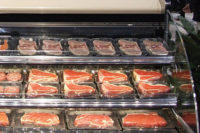
New waves of regulations and utility rebates are major
issues in the refrigeration sector.
An update on the changes coming have been released in a white paper from Emerson Climate Technologies titled, “Status of Energy Regulations for Commercial Refrigeration Equipment.”
The paper was co-authored by Robert Lehman, product leader for Emerson Intelligent Store architecture, and Brian Buynacek, a senior consultant with Emerson Design Services Network, and released earlier this year. It looks at a growing regulatory environment stretching back to 2001 with the Environmental Protection Agency’s Energy Star® program enacting voluntary energy-consumption guidelines for commercial refrigerators and freezers.
From there, the California Energy Commission used those guidelines to mandate such standards in its state while outlawing the sale of nonconforming products. Other states then started adopting the California standards.
Then, it was noted, in 2005 the Air-Conditioning and Refrigeration Institute (ARI) took a pro-active stand and recommended standards to Congress “that were equal to the most stringent in California.” From there came the national Energy Policy Act that included the ARI recommendations which becomes law in 2010.
And “more regulations are on the horizon,” the authors said. “Additional standards for ice machines are expected in 2010 and the Department of Energy will make a ruling on display cases by 2009 that will become effective in 2012.”
MEETING EFFICIENCIES
Since manufacturers must meet those standards to be able to sell products, efforts are underway to fine tune equipment in an entire range of refrigeration categories.In the broadest sense, Lehman and Buynacek said, “Original equipment manufacturers can comply with existing and pending energy-use regulations by selecting the most efficient component products. For example, the compressor can be responsible for up to 60 percent of a system’s total energy use. Evaporator- and condenser-fan motors are the second largest energy-consuming components.
“Scroll compressors and electronic-commutated motors are the most efficient compressor and motor options. Additional technologies, including system controllers, component diagnostics, and monitoring software can also help reduce overall product energy use.”
The white paper then offered perspectives on trends in various refrigeration sectors.

Walk-in freezers and coolers are giving more attention to
insulation and fan motors.
REACH-INS, WALK-INS
The report noted, “Multiple energy standards define allowable energy consumption for reach-in refrigerators and freezers. In 2010, a national minimum level of reach-in energy performance preempting any standard set by the states will be instituted. Also in 2010, new voluntary Energy Star standards in reach-ins are expected to be set. This will be base lined to capture the top 25 percent of energy performance after 2010.”For walk-ins, which face similar standards, the authors offered what they called “prescriptive standards or design guidelines.”
They suggested that walk-in refrigerator and freezer rooms utilize automatic door openers, high-efficiency wall insulation, and high-efficiency evaporator-fan condenser-fan motors. “Additionally,” they said, “walk-ins with glass doors must use triple-pane glass and must control or limit the total power used by antisweat heaters.”
ICE MACHINES
In the ice machine sector, the issue was not only energy usage “but also the efficient use of water to promote water conservation.”Like much of the refrigeration sector, there are multi-tier efficiency guidelines with those guidelines reviewed from time to time for additional changes.

Ice machine manufacturers are paying as much attention to water
conservation methods as electrical energy conservation.
DISPLAY CASES, ETC.
In many respects, standards related to display cases, ice cream freezers, and vending machines are on an even faster track for adoption.According to the white paper:
“A DOE ruling is in process that covers remote and self-contained display cases. The Analyses for Advanced Notice of Proposed Rulemaking (ANOPR) will occur by April 2008. Testing will be performed using the ARI-1200 procedure. The ruling is expected in 2009, after a Department of Justice review and will be effective Jan. 1, 2012. The ongoing analysis reviews design options, efficiency and cost tradeoffs, life-cycle cost and payback, and the impact on manufacturers.
“New standards specifically for ice-cream freezers with either solid or glass doors were introduced in the April 2005 release of the updated CEC standards as well, with an effective date of January 2007.
“Specific vending machine energy-consumption standards were also introduced in the April 2005 release of the updated CEC standards with an effective date of January 2006. The formulas to calculate the allowable energy consumption for vending machines are based on a unit’s rated capacity to store 12-ounce cans.”
INCENTIVES
The authors encouraged monitoring of utility companies who might offer consumer rebates and incentives for the purchase of high-efficiency commercial refrigeration equipment.For those interested in downloading the white paper, go to www.emersonclimate.com/energy.htm.
Publication date:05/05/2008



